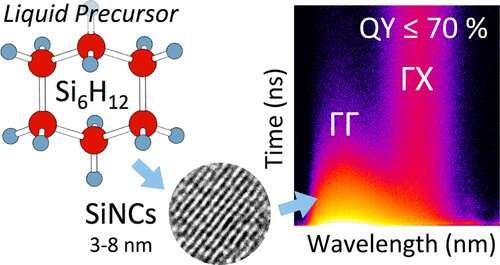Credit: ACS
NDSU researchers recently developed a new method of creating quantum dots made of silicon. Quantum dots, or nanocrystals, are tiny nanometer-scale pieces of semiconductor that emit light when their electrons are exposed to UV light. The most common application of quantum dots is in QLED displays. Through their use, digital displays have become brighter and much thinner, resulting in improvements to television and, potentially, cell-phone technology.
Because silicon is abundant and nontoxic, silicon quantum dots have unique technological appeal. Silicon quantum dots are currently being used for applications such as windows that remain transparent while serving as active photovoltaic collectors of energy, and they hold promise in medicine where quantum dots are coated with organic molecules to create nontoxic fluorescent biomarkers.
While traditional methods for creating silicon quantum dots require dangerous materials such as silicon tetrahydride (silane) gas or hydrofluoric acid, the NDSU team's research uses a liquid form of silicon to make the tiny particles at room temperature using relatively benign components.
The team, led by Erik Hobbie, professor of physics, coatings and polymeric materials, and director of the graduate program in materials and nanotechnology at NDSU, relied on the discoveries of NDSU Distinguished Professor of Chemistry Philip Boudjouk, who developed the liquid precursor (cyclohexasilane or Si6H12). NDSU alumnus Todd Pringle was the lead researcher on the project. Pringle is the president of Lumacept Inc., a company that produces the only available coating designed to reflect germ-killing ultraviolet light, called UV-C. Lumacept is currently helping health care providers decontaminate and re-use their personal protective equipment.
"This approach has the potential to take the production of these materials to a new level of quality and scale," Hobbie says. "I believe this is the best work I've been involved with in my career and I'm very proud that it was done at NDSU." The work was supported by the National Science Foundation.
Their research paper "Bright Silicon Nanocrystals from a Liquid Precursor: Quasi-Direct Recombination with High Quantum Yield" was published by the American Chemical Society in the April 2020 journal ACS Nano.
More information: Todd A. Pringle et al. Bright Silicon Nanocrystals from a Liquid Precursor: Quasi-Direct Recombination with High Quantum Yield, ACS Nano (2020). DOI: 10.1021/acsnano.9b09614
Journal information: ACS Nano
Provided by North Dakota State University























